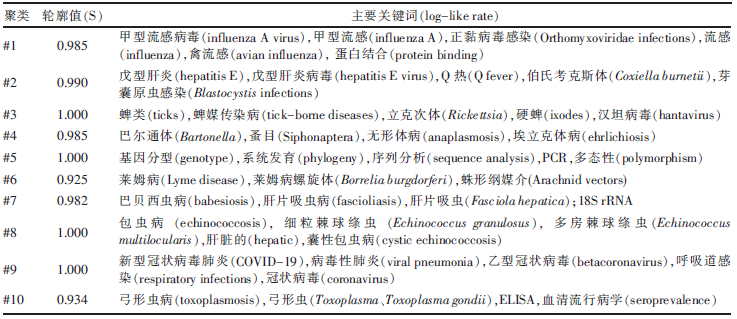| [1] |
World Health Organization (WHO). Zoonoses[EB/OL].(2020-07-29). https://www.who.int/news-room/fact-sheets/detail/zoonoses.
|
| [2] |
余登友. 新发病毒性人畜共患传染病的影响因素、预防与控制[J]. 临床合理用药杂志, 2019, 12(23):178-179.
|
| [3] |
周泽将, 王浩然, 修宗峰. 积极构建中国特色管理学理论体系——基于NSFC管理科学A类期刊刊文(2013—2020年)的分析[J]. 管理世界, 2021, 37(9): 57-77.
|
| [4] |
王淑斌. 中西医治疗2型糖尿病的知识图谱分析[D]. 北京: 北京中医药大学, 2014.
|
| [5] |
屈睿升, 宋润泽, 刘宝坤, 等. 基于CiteSpace的近十年下腔静脉滤器领域文献计量可视化分析[J]. 临床放射学杂志, 2022, 41(2):334-339.
|
| [6] |
刘玮. 中国新发蜱媒病原体概况[J]. 传染病信息, 2017, 30(1):11-14.
|
| [7] |
魏子昕, 方圆, 张仪. 上海市蜱种类、分布及其携带病原[J]. 中国媒介生物学及控制杂志, 2022, 33(1): 120-124.
doi: 10.11853/j.issn.1003.8280.2022.01.022
|
| [8] |
田冰, 邓宝成. 蜱媒传染病相关病原体混合感染[J]. 中国人兽共患病学报, 2018, 34(9):830-833,844.
|
| [9] |
李娟, 刘翩, 邱菊, 等. 1例Q热肺炎诊治报告[J]. 中国人兽共患病学报, 2022, 38(2):187-189.
|
| [10] |
郭仕辉. 腹泻犊牛肠道菌群多样性及其粪便代谢组研究[D]. 银川: 宁夏大学, 2021.
|
| [11] |
许杰, 周文琪, 罗小兵. 髌股关节疼痛综合征研究热点与内容的可视化分析[J]. 中国组织工程研究, 2022, 26(12):1877-1887.
|
| [12] |
王超. 我国牛病毒性腹泻病毒研究热点与趋势分析[J]. 黑龙江畜牧兽医, 2022(6):77-81,137.
|
| [13] |
徐本锦, 宣焱, 杜淼, 等. 新冠病毒刺突糖蛋白结构与功能的生物信息学分析及原核表达[J]. 病毒学报, 2022, 38(1):41-56.
|
| [14] |
刘玲, 陈晓聪, 宣焱, 等. 新冠病毒受体蛋白ACE2结构与功能的生信分析及原核表达[J/OL]. 中国免疫学杂志:1-24(2021-12-02)[2022-04-07]. http://kns.cnki.net/kcms/detail/22.1126.R.20211129.1310.006.html.
|
| [15] |
陈婧瑜. 美国《Emerging Infectious Diseases》2021年第4期有关人兽共患病论文摘译[J]. 中国人兽共患病学报, 2021, 37(6):571-572.
|
| [16] |
张淳, 张媛媛. 基因测序技术在细菌性传染病监测中的应用[J]. 中国医学装备, 2017, 14(7):134-138.
|










